Reducing bacterial adhesion to titanium surfaces using low intensity alternating electrical pulses
INTRODUCTION
Orthopedic implant-related infection remains one of the most serious complications after orthopedic surgery.The incidence of infection after fracture surgery varies depending on the mechanism of injury from 1% in low energy closed fractures and up to 30% in high energy open fractures[1].The incidence of infection after primary hip and knee arthroplasty is 1%-3% and increases to up to 15% in revision surgery[2].The management of orthopedic implant-related infection usually requires a combination of surgical and prolonged courses of antibiotic treatment.In recent years,there has been an increased scientific interest to improve prevention and treatment strategies.Many of these strategies have focused on chemical measures to reduce and treat infections.
30. Must make in that time six shirts for us out of star-flowers: Note that the spell must be broken with a method similar to how it was cast. White shirts caused the enchantment, so the sister must make new shirts for her brothers to counteract the spell. Return to place in story.
Although the exact physiopathology of implant-related infections is unknown,infections are preceded by contamination of the surgical site (during surgery,postoperatively,or by hematogenous seeding) followed by bacterial adhesion and biofilm formation on the metal surface.Depending on several variables such as bacterial load,host immunity,and microorganism virulence,early or delayed implant infections can occur.
The antibacterial properties of electric currents have been used since the past century.In 1919,Anderson[3] published a method to sterilize milk using low frequency alternating current (AC).In non-medical related fields such as industrial water or food processing,high voltage electrical currents are commonly used to eliminate microorganisms and debris.
Focusing on the medical field,Costerton[4] were the first to postulate the potential uses of electrical currents for the treatment of artificial implant infections.From that point on,an increasing number ofstudies have demonstrated the capacity of low-intensity electrical currents to inhibit bacterial growth of different(),andstrains.Moreover,they described the “bioelectric” effect caused by the antibacterial synergies between antibiotics and electric fields against biofilm bacteria[5].
However,many of these studies are focused on the use of direct current (DC).It is important to note that DC has potential drawbacks for itsuse.DC generates water electrolysis and can cause changes in pH and free radicals that could be cytotoxic.Furthermore,DC generates higher amounts of energy that can cause electrocorrosion and/or oxidation of the metal electrodes making its applicability limited in clinical scenarios with metallic implants.
The second day all the men returned to the classroom. This was particularly pleasing to me. Even the young blond man. This was the day for reading and taping. I wondered how the silent, shy student would handle this. I was actually surprised to see him there. He had combed his long, blond hair and his shirt was neatly12 pressed. He had obviously thought about the fact that he was going to be filmed and wanted to look his best. At last I was going to hear what he wrote.
Orthopedic surgical procedures commonly involve the use of biocompatible metals such as titanium.The reduction of bacterial adherence to metal surfaces using electrical fields has been described for stainless steel[6].To the best of our knowledge,there is no evidence of the effect of electrical currents on reducing bacterial adherence to titanium surfaces.
The objective of our study was to analyze the effect of AC electrical fields on bacterial adherence to a titanium surface for gram-positive and gram-negative bacteria.The secondary objective was to analyze the effect of electrical fields to titanium and the medium.
MATERIALS AND METHODS
Titanium plate manufacturing
The medical titanium (Ti-6Al-4V) components used in our study were manufactured and supplied by AMES S.A.(Sant Feliu de Llobregat,Barcelona,Spain) Circular disks were obtained from cutting titanium bars.Each disk was mechanically polished to remove irregularities and to promote identical physical conditions at the surface for all disks.
19. Lucifer-match: Simply a match. A Lucifer match or friction47 match was invented in 1826 by John Walker (Evans 663). It was then copied by Samuel Jones of the Strand48 and sold as the Lucifer (c. 1829) (Evans 663).Return to place in story.
He had now to begin all his work over again, but by this time it only wanted an hour of evening, when the witch was to be expected home, and he easily saw that it was impossible for him to be finished by that time
Design and manufacturing of culture plates
The design of a culture plate that would allow a simultaneous number of tests with different electrical conditions was important to standardize the study process and optimize resources.A self-designed 12-well culture plate was designed and manufactured by Innovative Minds S.L.to achieve this goal.Using a standard plastic 12-well culture plate with 3 rows and 4 columns (Nunclon-Thermo Scientific),holes were drilled at the bottom of each of the wells to fit titanium electrodes at the base.The top or lid of the wells was also drilled to place a disk at the top to serve as an electrode.This setup allowed the 12 wells to have cylindrical titanium electrodes at the top and bottom of each well.All electrodes were connected to a generator and an amplifier as seen in Figure 1A.The function generator had four separate connections to allow four different trials to be performed simultaneously and in a triplicated manner.To generate the desired waveforms,an AFG1022 Dual Channel Arbitrary Function Generator (Tektronix Inc.,Beaverton,OR,United States) was used.The signal was amplified by an OPA548EVM Power Operational Amplifier (Texas Instruments Incorporated,Dallas,TX,United States).One amplifier per channel was used.The power op-amps were powered by an off-the-shelf 15 V symmetric power supply.(Figure 1A and B).
I hope we ve got what it takes to make our love last. As a bride, I had Scott s wedding band engraved17 with Robert Browning s line Grow old along with me! We re following those instructions.
Effects of the electrical field on titanium and medium without bacteria
Before conducting the study with bacteria,we performed a series of analyses to evaluate possible interactions between electrical fields and the titanium plates and brain heart infusion (BHI) medium.
The main objectives of this test were: (1) To obtain the threshold voltage at which electrocoagulation and electrolysis were seen in the culture medium; and (2) To evaluate if at this point of voltage there was macroscopic signs of oxidation of titanium plates.For these reasons,two 15 mm diameter and 2 mm thick titanium disks were suspended at the base of a well in a 6-well culture plate (Nuclon Delta Surface,Thermo Fisher Scientific,Waltham,MA,United States) petri dish covered in 4 mm of BHI.The two disks were separated by a 5 mm distance as shown in Figure 2A.The left electrode was connected to the negative (catode) pole of a DC power supply,while the right electrode was connected to the positive (anode) electrode of the same supply.A USB microscope [913-2478,Electrocomponents PLC (RS Pro),London,United Kingdom] was set up and shown in Figure 2B to visualize and count bubble formation.A constant potential difference was applied between the two electrodes during a 10-min period.We then evaluated: (1) The presence of titanium oxidation by controlling the change of color of the surface; (2) The presence of bubbles and the quantity during one minute to estimate the number of bubbles formed during exposure; and (3) The formation of lumps as a consequence of medium electrocoagulation.
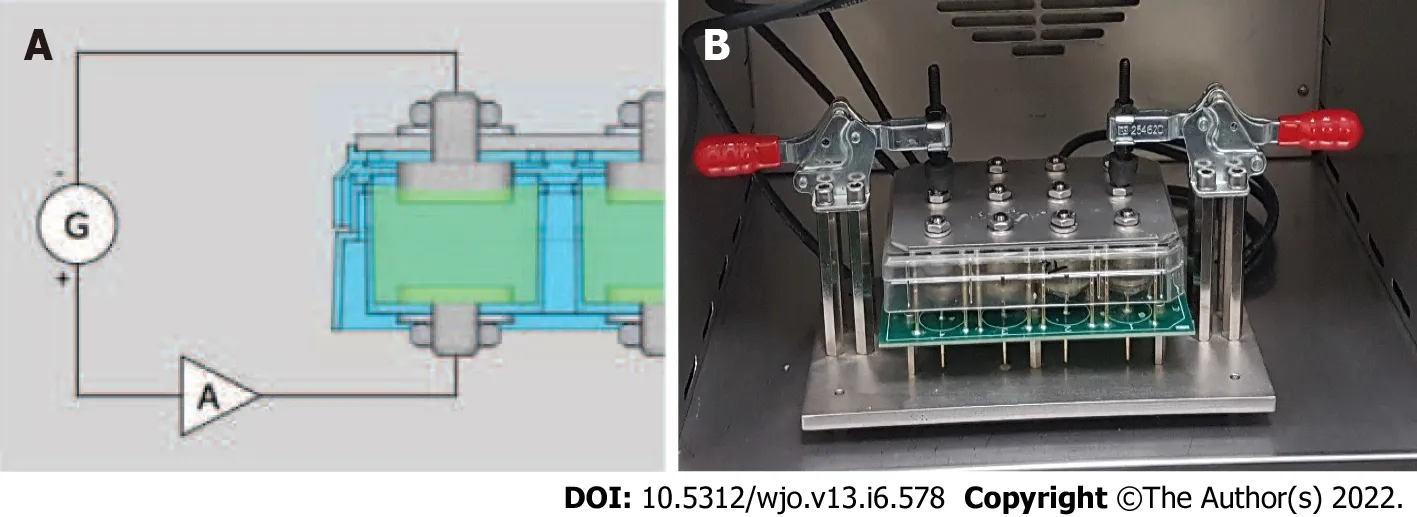
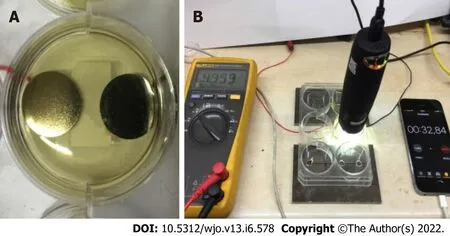
The presence of lumps was evaluated using a Zeiss Neon scanning electron microscope operated at 15 keV,equipped with energy dispersive X-ray spectroscopy to examine their composition.Energy dispersive X-ray spectroscopy line profile and energy dispersive X-ray spectroscopy mapping analyses were performed to detect the presence of calcium,phosphate,sodium,and potassium.
Bacterial adhesion experiments
Using the self-designed 12-well culture plate mentioned above,we analyzed the potential effect of electrical currents in reducing bacterial adhesion to a titanium metal surface.Our self-designed culture plate allowed four different conditions to be tested by triplicate at the same time.
Regarding the electrical model,the most successful studies have used DC currents.Theoretically,under the influence of ACs,fewer electrons and therefore less energy is applied to the system.This could explain the lower rate of adhesion reduction achieved by ACs compared to DCs described by van der Borden[8].However,the use of AC could prove to be feasible for the treatment in clinicalscenarios.
He hardly finished speaking when he found himself back again with his wife, while all the other inhabitants of the palace were lying at the bottom of the Red Sea
After exposure,non-adhered bacteria were removed by aspiration of the medium followed by three rinses with PBS.Then,1 mL PBS was added,and the plate was sonicated in a Xuba1 Ultrasonic bath (Grant Instruments,United Kingdom) to detach the bacteria adhered to the bottom titanium electrode.Subsequently,serial dilutions of detached bacteria were streaked onto BHI agar plates and incubated overnight at 37 °C.Colony-forming units per milliliter were counted.All tests were repeated three times,and mean values were reported.
The King and Queen were only too delighted to have this charming Princess to supply the place of Prince Featherhead, whom they saw but seldom, since the Fairy had provided him with a palace in the neighbouring town, where he lived in the greatest luxury, and did nothing but amuse himself from morning to night
Presence of bacteria at the titanium disc surface was evaluated by scanning electron microscope.After incubating the bacteria with different electrical currents as described above,discs were rinsed thrice with PBS,and bacteria were fixed with a 2.5% glutaraldehyde solution.Discs were then washed and dehydrated in a series of increasing ethanol solutions for 20 min each.Complete dehydration was performed after incubation in hexamethyldisilazane.Dried samples were covered with a thin carbon layer and mounted on aluminum stubs.Samples were observed using a Zeiss Neon at an operating voltage of 5 kV.
Other variables registered included presence of electrocoagulation of the medium (lumps),electrode oxidation,and changes in pH of the medium.The pH was measured in the collected supernatants using a selective MultiMeter MM41 (Crison Instruments) electrode.
He therefore resolved to travel for change, and by means of his magic art was able to visit every country he came to see under different shapes, returning every few weeks to the place where he had left a few followers9
Using a self-designed 12-well culture plate,we analyzed the potential effect of electrical currents in reducing bacterial adhesion to a titanium metal surface.Gram-positive bacteria,represented by(),and gram-negative bacteria,represented by(),were exposed to 6.5 V electrical currents at different frequencies: 0.5 Hz,0.1 Hz,and 0.05 Hz.After exposure,colony-forming units per milliliter were counted and compared to a control without exposure to electrical currents.
Let us see what is in the other casket, before we get into a bad humor, saidthe Emperor. So the nightingale came forth5 and sang so delightfully7 that atfirst no one could say anything ill-humored of her.
RESULTS
Effects of the electrical field on culture medium
No changes in pH were found in any of the tests performed.In all studied conditions,anodizing at the titanium electrodes was observed creating an ochre and purple coloring (Figure 6).
We also noted the formation of lumps in the culture medium due to electrocoagulation.For this reason,we tested two different voltages,7.5 V and 6.5 V,to evaluate the effect of electrocoagulation in our medium.We applied these potential differences and observed there was an increased agglomeration when using 7.5 V.We did not observe agglomeration using 6.5 V.Taking into consideration these results,we decided to establish 6.5 V as a safe potential difference in our setup to minimize the effect of electrolysis and electrocoagulation on our results.
Bacterial adhesion experiments
After establishing a reference voltage at which electrocoagulation and electrolysis were minimized,we proceeded to carry out the experiments on bacteria following the previously described methodology.
Changes in pH have also been described to influence bacterial growth.This principle is commonly used in detergents and disinfectants to kill bacteria[13].Large variations in external pH have biocidal effects on bacteria[14].In our study,we did not observe changes in pH.For this reason,we can establish that the effect on bacterial adhesion is directly related to the electrical current and not caused by a change of pH in the medium.
For,the 0.05 Hz frequency model also showed the most effective results with a 53% adhesion reduction rate,although these were lower than.Bacterial counts in the control were 6.53e6 colony-forming units (Figure 4B).
Although we performed tests to establish a high threshold voltage to minimize the effects of electrocoagulation and electrolysis of the culture medium,these phenomena were observed in all tests when bacteria were present in the medium.The lumps were analyzed using energy dispersion X-ray spectroscopy to determine their composition.We concluded these were formed by titanium ions,due to oxidation of the electrode,and other ions (P,K,Na) from the salts in the medium.Furthermore,when the lumps were visualized under an electron microscope,bacteria were seen in the surface and inside the lumps as shown in Figure 5.
You did not know, any better! Ignorance upon ignorance indeed! The poor swineherd took these words to heart, for they wereaddressed to him; he knew not that there were others who wereequally ignorant. Not even a leaf of the plant could be found. Therewas one, but it lay in the coffin of the dead; no one knew anythingabout it.
During our preliminary tests,we had observed the formation of hydrogen microbubbles from the negative electrode and a fewer amount of oxygen bubbles from the positive electrode when high voltages were used.This phenomenon was attributed to electrolysis.We therefore had to establish the threshold potential at which electrolysis did not occur for our setup.Our results showed the decomposition potential for our setup started at 5 V.An exponential increase in bubble formation was reported at 6.5 V (Figure 3).
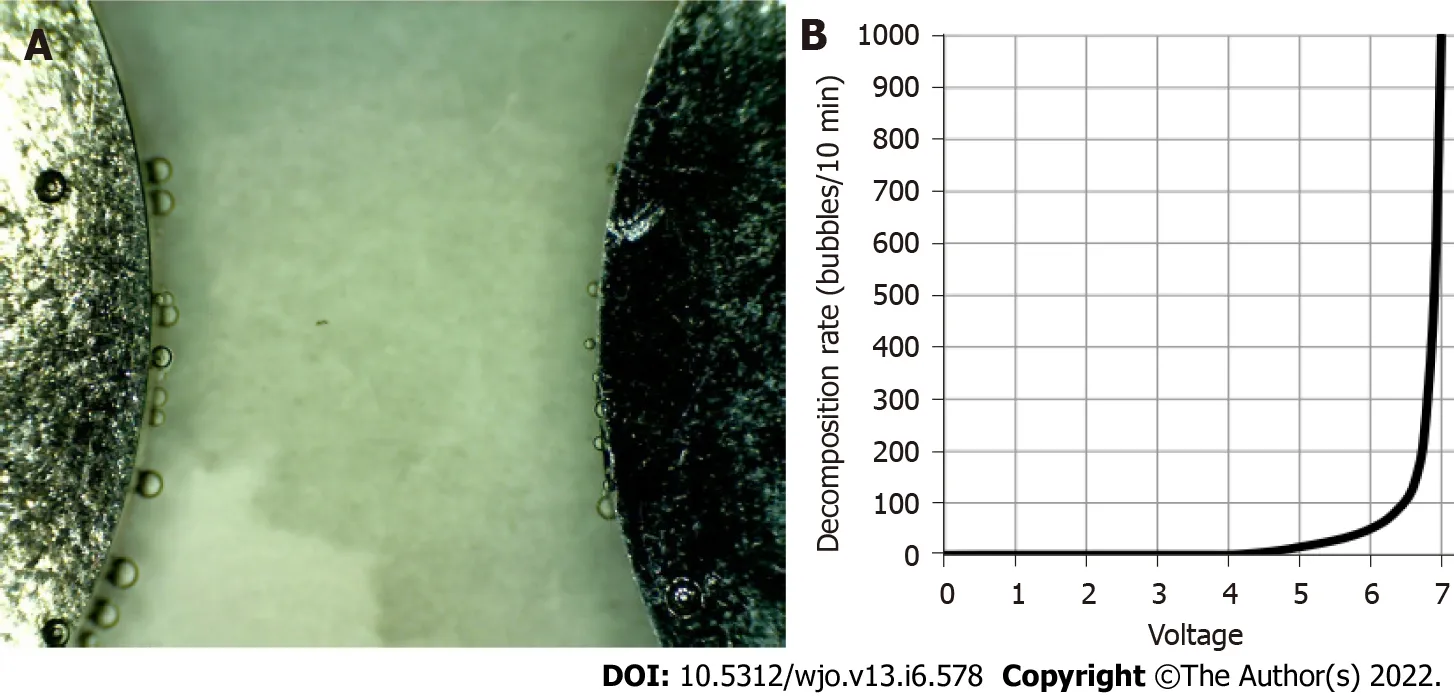
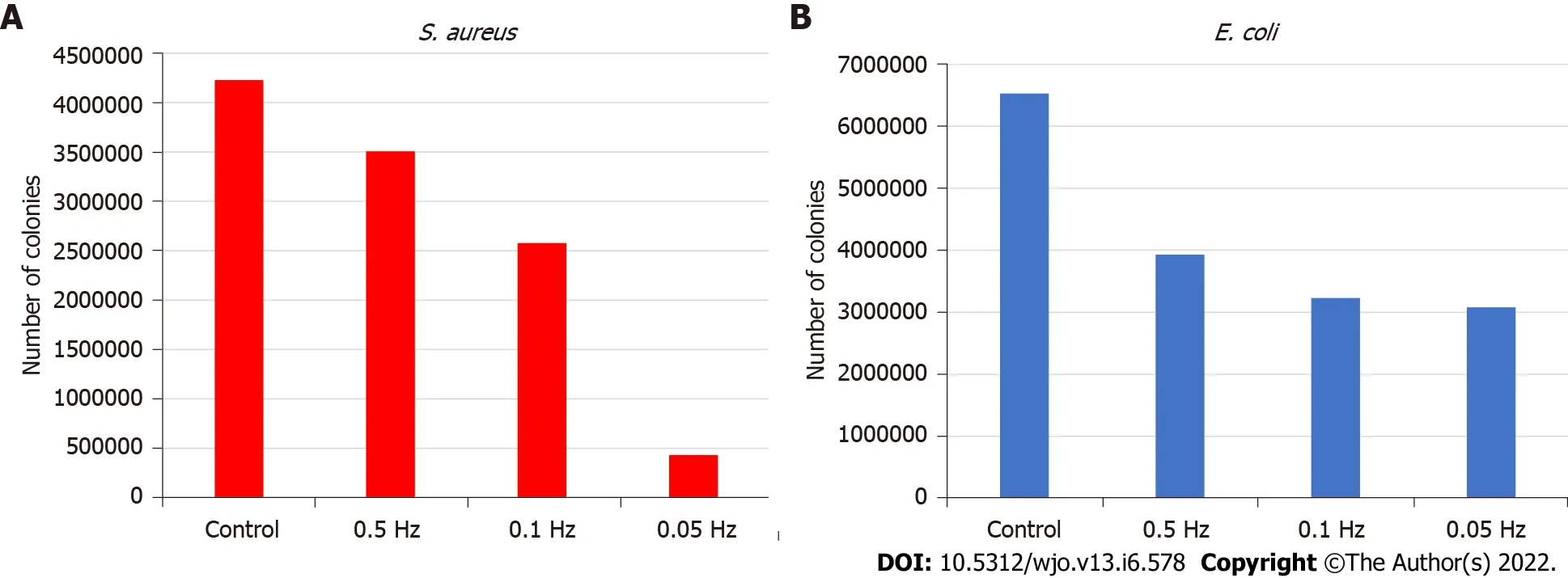
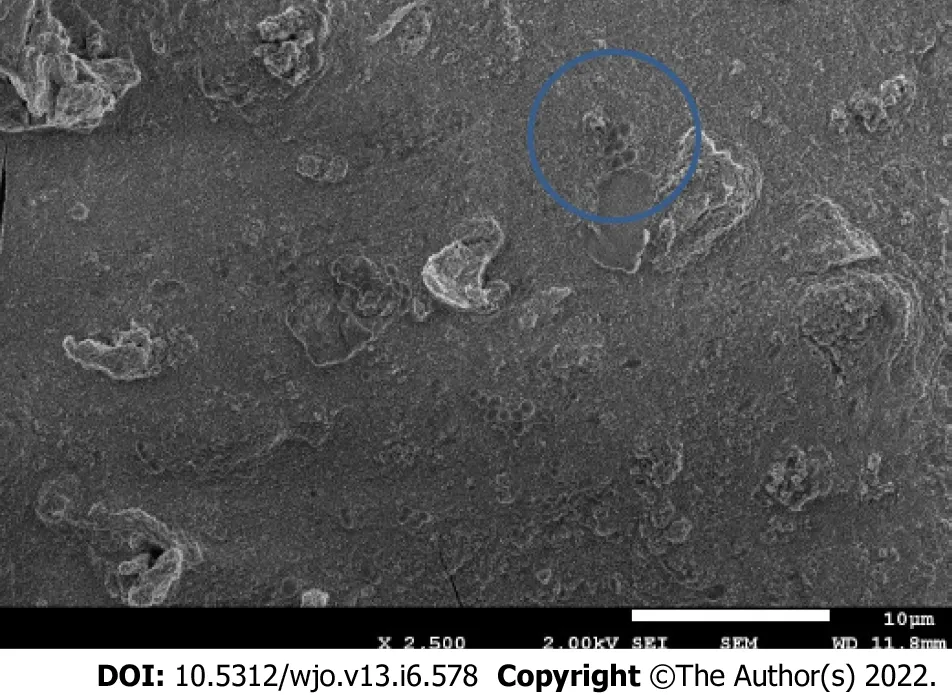

DISCUSSION
The results of our study suggest it is possible to achieve a reduction in the adhesion ofandto titanium surfaces using low intensity alternating pulsed electrical currents.Most current research regarding electrical currents and bacterial adhesion to metal surfaces have been performed in a variety of custom-designed electrical devices to serve the purpose.Previous results using parallel plate flow chambers as described by Poortinga[7] and performed by van der Borden[8,9] showed that a variety of staphylococcal strains could be detached from surgical stainless steel by the application of a direct electrical current.The authors of this study attributed this detachment mechanism to an ionicstrength dependent transfer of electrons.This explained the increased detachment rate with higher currents.They also described the detachment force to be proportional to the voltage applied and that this force needs to overcome the attractive Lifshitz-Van der Waals and the acid-base forces between the adhering bacteria and the surface.
To reduce the number of bacteria adhered to a metal surface; these forces also need to be neutralized.The mechanism of bacterial adhesion to metal surfaces is complicated.Bacterial adhesion to a metal surface can be described as a two-phase process including an initial and reversible phase (phase one) and a time-dependent irreversible phase (phase two),which was first proposed by Marshall[10,11].Planktonic bacteria interact with metal surfaces following a series of physical forces such as gravity,electrostatic charges,hydrophobic interactions,Brownian motion,and van der Waals attraction forces.In phase one,when the cell and the surface come into close contact (< 3 nm),short-range interactions such as hydrogen bonding and ionic and dipole interactions become effective for bacterial adhesion.At this point the electrical currents play an important role for preventing bacterial adhesion to metal surfaces by interacting with these forces.In the second phase of adhesion,molecular reactions between bacterial surface structures become predominant[12].Other factors affecting bacterial adhesion include characteristics of bacteria themselves,the target material surface,and environmental factors such as the presence of serum proteins or bactericidal substances[12].
The experiments were performed using a gram-positive strain,(CCUG 15915),and a gramnegative strain,() (CECT 101).Both bacteria were individually streaked in BHI (Scharlab SL,Spain) agar plates.Colonies were grown in BHI broth overnight at 37 °C and diluted to an OD600 of 0.2.Three milliliters of this medium were then inoculated to the self-designed plates containing titanium discs.Bacteria were incubated at 37 °C for 2 h,applying 6.5 V pulsed electrical currents at different frequencies,0.5 Hz,0.1 Hz,and 0.05 Hz,to prevent attachment.A control without exposure to electrical fields was used as maximum bacterial adhesion.Each condition was tested with titanium electrodes provided at each end of the wells.
For customer service answering the telephone is very important, our ringing normally6 comes from the information desk, tills, customers and others. Mostly they ask for prices, advice or looking for some staff to use. At the beginning, if I was near the telephone I liked to pick up and answer it, after a few times I was afraid, because I couldn’t completely7 understood what’s said by the customer at the phone.
Our study results show adhesion reduction rates of up to 90% forusing AC low intensity alternating pulses.However,we only achieved 53% adhesion reduction rates for.As previously pointed out,many factors influence bacterial adhesion.We believe this difference could be explained by
the different cell structure of the studied bacteria.Most prokaryotic cells are known to have a rigid cell wall.This cell wall is essential for viability,protection,and structure.There are significant differences in the composition ofandcell walls.The Gram stain test is a quick way to classify bacteria into two broad categories (gram-positive or gram-negative) according to their cell wall characteristics.The most significant difference between these two groups of bacteria is that gram-positive bacteria are marked by the absence of an outer lipid cell membrane.In general,gram-positive bacteria are considered monoderms and have a single lipid layer as opposed to gram negative bacteria that are diderms and have two lipid layers.We have hypothesized that our results improve when increasing the amount of energy applied to S.aureus but remain constant with E.coli due to these structural differences,making gram negative bacteria more resistant to forces caused by electrical currents.
The most effective electrical model for reducingadhesion was 6.5 V AC at 0.05 Hz achieving a 90% adhesion reduction rate.Bacterial counts in the control were 4.22e6 colony-forming units (Figure 4A).
So when she had rubbed the sleep out of her eyes, and wept till she was weary, she set out on her way, and thus she walked for many and many a long day, until at last she came to a great mountain
Additionally,the effects of electrolysis and electrocoagulation in the presence of bacteria and BHI have shown several a priori unexpected reactions.The formation of lumps formed due to electrocoagulation of the medium showed the presence of bacteria when examined under an electron microscope.Additionally,we cultured these lumps to establish if there was living bacteria.Although we cannot be sure if the samples were contaminated by the suspended bacteria in the culture medium,we can almost be sure electrical fields,at the voltages used,do not directly kill bacteria,and prevent them from adhering to the metal surface.To the best of our knowledge there are no current studies in the literature that evaluated this phenomenon.Therefore,we have not found any references regarding this topic.
CONCLUSION
Notable adhesion reduction rates were observed forandin the studied conditions.However,the presence of electrolysis and electrode oxidation lead us to presume these conditions are not optimal foruse.Although our findings suggest alternating electrical currents may be useful in preventing bacterial adhesion to titanium,further research using other electrical conditions must be examined to consider their use fortrials.
ARTICLE HIGHLIGHTS
Research background
Orthopedic implant-related infection remains one of the most serious complications after orthopedic surgery.In recent years,there has been an increased scientific interest to improve prevention and treatment strategies.Many of these strategies have focused on chemical measures to reduce and treat infections.
On the second last day of the tour we were making our way to Calais and the ferryboat that would take us back across the English Channel, on to London and finally the airport. Throughout the war memorial that the people of France erected4 to the Canadian soldiers who fought so bravely here the trip as we rode along in the coach our wonderful French guide provided a colourful and interesting commentary to give us a better understanding of what we were seeing out the window.
Research motivation
Our study group has been developing novel strategies for the treatment and prevention of orthopedic implant-related infections.These have been focused on the application of electrical currents to surface metals in the presence of bacteria to prevent adhesion and disrupt biofilm formation.
Research objectives
The objective of our study was to analyze the effect of alternating current electrical fields on bacterial adherence to a titanium surface for gram-positive and gram-negative bacteria.
Research methods
The results shown in this manuscript are part of a thesis project titled “Utility of electrical currents for the prevention and treatment of orthopedic implant-related infections” (Universitat de Barcelona).
Research results
The most effective electrical model for reducingadhesion was 6.5 V alternating current at 0.05 Hz achieving a 90% adhesion reduction rate.For,the 0.05 Hz frequency model also showed the most effective results with a 53% adhesion reduction rate,although these were significantly lower than.
Research conclusions
Our results demonstrate electrical fields may have promising applications in preventing bacterial adhesion to titanium metal surfaces.However,the presence of electrolysis and electrode oxidation lead us to presume these conditions may not be optimal foruse.
Research perspectives
Further research using other electrical conditions must be examined to consider their use fortrials.
This study was developed through the DIRECT project (Desarrollo de Nuevos Dispositivos Biomimé ticos Mejorados Superficialmente con Nuevos Recubrimientos y Tratamientos Físicos),which has been funded with a grant from the Centre for Development of Industrial Technology (CDTI).The CDTI is a Public Business Entity,answering to the Ministry of Science and Innovation of the Spanish Government.
Bernaus M,Guillem-Martí J,and Font-Vizcarra L have made substantial contributions to research design,acquisition,analysis,interpretation of data,and drafting the manuscript; Bermúdez A,Calero JA,Torres D,and Veloso M have made substantial contributions to interpretation of data and critically revising the manuscript; All authors have read and approved the final submitted manuscript.
Each author certifies that he or she has no commercial associations (,consultancies,stock ownership,equity interest,patent/Licensing arrangements,) that might pose a conflict of interest in connection with the submitted article.
This article is an open-access article that was selected by an in-house editor and fully peer-reviewed by external reviewers.It is distributed in accordance with the Creative Commons Attribution NonCommercial (CC BYNC 4.0) license,which permits others to distribute,remix,adapt,build upon this work non-commercially,and license their derivative works on different terms,provided the original work is properly cited and the use is noncommercial.See: https://creativecommons.org/Licenses/by-nc/4.0/
Spain
Marti Bernaus 0000-0001-9458-6337; Jordi Guillem-Marti 0000-0003-0307-2221; Adrian Bermúdez-Castel 0000-0002-3081-0325; Jose Antonio Calero 0000-0003-3354-7179; Diego Torres 0000-0001-9751-7097; Margarita Veloso 0000-0002-6200-0490; Lluís Font-Vizcarra 0000-0002-8776-8009.
Zhang H
Filipodia CL
Zhang H
World Journal of Orthopedics2022年6期
- World Journal of Orthopedics的其它文章
- Management of hip fracture in COVID-19 infected patients
- Topical use of tranexamic acid:Are there concerns for cytotoxicity?
- Content of blood cell components,inflammatory cytokines and growth factors in autologous platelet-rich plasma obtained by various methods
- Evaluation of artificial intelligence models for osteoarthritis of the knee using deep learning algorithms for orthopedic radiographs
- Role of joint aspiration before re-implantation in patients with a cement spacer in place
